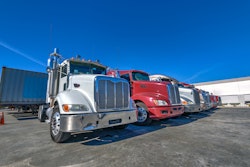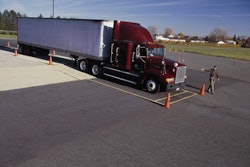President Donald Trump this past Saturday made good on his campaign promise to enact 25% tariffs on goods imported from Canada and Mexico, and tacked on 10% to goods from China, increasing duties on the U.S.’s largest three import/export partners.
Canada and Mexico earned a 30-day reprive following promises to secure their borders against the flow of illicit drugs and illegal immigrants, but considering trucks move 85% of goods across the southern U.S. border and 67% of goods across the northern border, U.S. motor carriers are exposed to the fallout of these tariffs even if cross-border isn’t part of their business.
Speaker 1:
What do new tariffs on the US' three biggest trade partners mean for motor carriers and consumers? You're watching CCJs 10 44, a weekly episode that brings you the latest trucking industry news and updates from the editors of CCJ. Don't forget to subscribe and hit the bell for notifications so you'll never miss an installment of 10 44. Hey everybody, welcome back. I'm Jason Cannon and my co-host is Matt Cole. President Donald Trump. This past Saturday made good on his campaign promise to enact 25% tariffs on goods imported from Canada and Mexico, and he tacked on 10% on goods from China. That increases duties on the us' three largest import export partners.
Speaker 2:
Trucks move 85% of goods across the southern US border and 67% of goods across the northern border and US motor carriers are exposed to the fallout of these tariffs, even if cross border isn't part of their business,
Speaker 3:
The 25% figure that has been raised, you got to keep in mind that tariffs, they don't work in a vacuum, right? So when if a 25% tariff gets levied, then there's going to be retaliatory tariff and you tend to have a little bit of an escalating tariff or a trade war that goes to spins out of that. There's certain things like oil and gas, that's a really important sector, and if you look at the amount of oil that's being imported, around half of America's oil is being imported and a lot of that is coming from Canada. 60% of that's coming from Canada. And then the second biggest trading partner for oil is Mexico. So when you put both of those things together, it's a sizable amount of the raw inputs that's going back and forth across the border and the tariffs that are associated with that.
And then also for all the carriers, just the cost of fuel. This is for the inputs going in. So if it's going up maybe 10% or more on the inputs, who knows what's going to go on the pump. So I think there are going to be big consequences that come from this if this goes into play and because we're going to be seeing on both sides of the border, the tariffs go up and it's going to affect stuff that's coming into the US and also the flows that are going out of the us. So it's going to be sizable. It's really going to be sizable with tariffs come counter tariffs, that equal and opposite reaction that is going to be happening, which is going to make it harder for us to essentially do business over the next few years. And what it's going to also mean is that companies have to really stay on top of that. Whether you're a freight forwarder and you're managing stuff that crosses the borders or whether you're a manufacturer and you're counting on where you're going to be putting your investment and where you're going to be sourcing products from, these are important decisions that we've got to be considering here.
Speaker 1:
Now, there is some ongoing flexibility as to implementation with these tariffs, which were supposed to kick off this past Tuesday. But regardless of when they start, if they start, they really couldn't have come at a worse time for trucking because we're currently in the very early stages of digging ourselves out of some pretty lean times that have lasted for more than a year. And John says any effects will probably be felt really quickly.
Speaker 3:
It's going to be a little buffer. It's going to go and depend on the different commodities that you're talking about. If it's something that feeds into a manufacturing line, for example, there's a little bit more of a lag. You're taking something in, you're building product, you put it out. So from an automotive perspective, the automotive parts feeding in it will take longer to go and get realized. But there are other things. If you're thinking of finished goods coming across borders, going to a retailer for example, that's going to hit you right away because as soon as that gets soon implemented, that shipment that's driving across the border is going to be subject to that tax. And the retailers, they've got pretty narrow margins, so they're not going to absorb it, where's it going to go? It's going to get passed through to the consumer. So on some of these things, you may get a really fast reaction.
Other ones, if it's more inputs into manufacturing and depending on how fast the lead times are for manufacturing, there'll be a delay and there'll be a lag there. But there are going to be some pieces where people are going to feel immediately. We talked a little bit about speed of what it's going to hit the consumer, but there's also the speed of which companies can make change within their supply chains. You can sign a tariff into law at the stroke of a pen, right? Really fast. It just happens. But changing these supply chains have been built for over, they took decades to go and build. They're going to take years if not decades to go and unwind and to change and to do all the rest. So it's really easy to go and sign something into law. It's hard for the rest of the supply chains to effectively change.
And that affects everyone in the supply chain, whether you're making stuff, whether you're moving stuff, hauling stuff, doesn't matter what it is or consuming, it takes time for all that stuff to go and work through. And if you think from a manufacturing perspective, how long does it take to build a new plant? Three to four years. That's a long time. So even if you were say, let's go and bring, if the objective is to bring everything back, all manufacturing back to America, even if people went and aggressively the CEOs aggressively tried to go and put that in place, it would take three to four years at best to really start shifting the needle at all before you see any input on that. So there's this disconnect between the speed of putting things into place and actually making change. So that's just something else that we should be considering throughout all of this.
Speaker 2:
The list of things the US imports from the affected countries is long. And it might be easier to list the things that we don't get from Canada, Mexico, and China. But John says there are a few major ones,
Speaker 3:
As you mentioned, oil and gas. And then the really big one that follows after that is automotive. Because automotive of all of the industries, that's the one that's really gone and specialized or leaned into the free trade agreements. So originally it was an nafta, there's U-S-M-C-A, and over the past few decades they've really gone and optimized their supply chains to be working across the three countries. So there are parts and there's manufacturing flows back and forth from the us, Canada, Mexico, and sometimes on something like a transmission, you're going to get that single part in building that transmission is going to cross back and forth several times the border. And if each time there's a 25% hit on that, what's going to happen to the price of that? It's going to just go and collapse. And even if you think of vehicles that are made in America, well made in America, vehicles have around 30% of imported parts in there. So all of those parts are going to get really impacted on it. And then of course there's also automotive cars that are made in Canada that are brought into the US for sale and Mexico as well. So those things come with the full 25% sticker price. So I think automotive out of all of 'em is going to be hit the hardest. Then we're talking oil and gas and lumber's another one, which is going to be a big thing.
Speaker 1:
Tariffs aren't a new thing. Plenty of goods that are imported into the US every day are tariffed. But John says what's different here and now is that these tariffs were inactive more as punitive measures an attention getter, if you will. And that's not really been the case throughout history.
Speaker 3:
Tariffs are useful. They're a useful tool to have in your toolkit. And where you want to use tariffs is if there's unfair trade practices. So let's say there's another government which is going subsidizing a certain industries, EVs, for example, China and EVs. And so you're going to try and protect the domestic industries because they don't have this benefit of all of this additional money flowing in. Another one is national security, and then a third area is to go and apply political pressure to go and change policy outcomes. And so when you're thinking of creating a level playing field, that makes a lot of sense and it is important to go and put these things in place. But when you're shifting into on the political side of it, like here, the tariffs are really try and change policy for fentanyl crossing the border and undocumented immigration, and that's really what the policy outcome is.
And so it's really kind of disconnected from those things. So I think we're going into a period over the next two years, we're going to have a lot of uncertainty and a lot of volatility, and we really don't know what's going to be happening within this because if they're focused in on the political side of creating a level playing field, those can be imposed and they could be retracted relatively quickly because it is not tied with fixing a structural problem. It's saying I want to try and put some leverage on. So I think we're going to be going into this period where we've got so much volatility that is going on, so it's going to make it really hard for folks. So to your point, I think we're kind of going backwards and I'm a believer in free trade across nations really goes and helps spur economies and it's NAFTA and US MCA been good for North America. And so I think we're going backwards. In this case,
Speaker 2:
Political and economic pundits have called these new tariffs. Everything from a non-issue to a good thing to an abject disaster. Exactly how this all plays out likely won't feel universal for everyone. But John says it's certainly not going to be good for consumer demand, and what's bad for the consumer is bad for road freight.
Speaker 3:
Tariffs are going to increase. Ultimately, if it goes across the board, it's going to increase the cost for consumers because as we talked about, the businesses are only able to absorb so much, which means it's going to get passed through the consumers. And if that happens, it can put pressure on the economy, it can raise inflation, and it can get the Fed acting and involved in interest rates going up, which is not, I don't think the objective for the consumers. I don't think they're looking to go and have their prices go up and inflation rates going up and interest rates going up, but there is a likelihood that that happens. It all depends on the scope and the scale of this, but if you get 25% across the board, there almost is no way to avoid that. In the us the last time I looked, the consumer was the economy and it's in 75% of the economy is driven by consumption. So if that goes and changes, that's not good for us.
Speaker 1:
That's it for this week's 10 44. You can read more on ccj digital.com. While you're there, sign up for our newsletter and stay up to date on the latest in trucking industry news and trends. If you have any questions or feedback, please let us know in the comments below. Don't forget to subscribe and hit the bell for notifications so you can catch us again next week.










